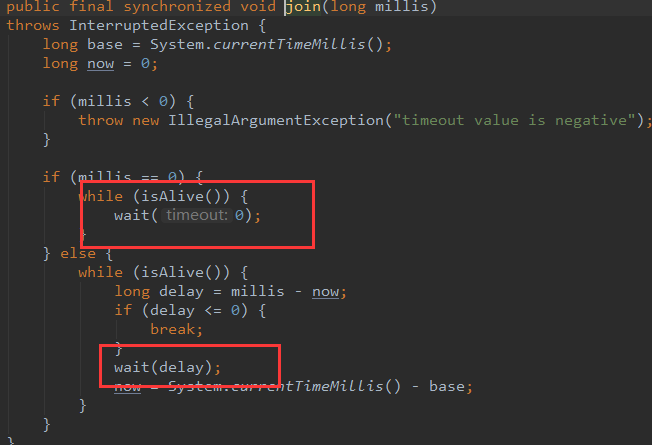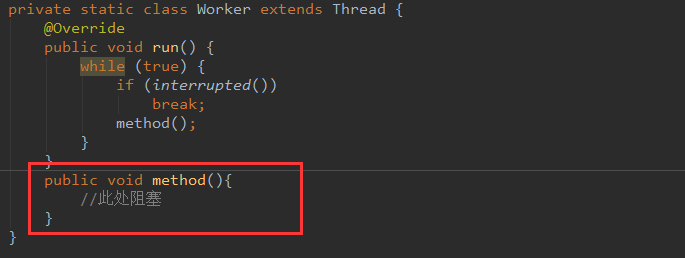在jdk中關于interrupt相關方法有三個:

簡單來使用一下interrupt:
```java
/**
* @program: ThreadDemo
* @description: 線程中斷
* @author: hs96.cn@Gmail.com
* @create: 2020-09-03
*/
public class ThreadInterrupt {
public static void main(String[] args) {
Thread t1 = new Thread("t1") {
@Override
public void run() {
while (true) {
}
}
};
t1.start();
// start之后處于runnable,并不一定馬上就會running。所以設置短暫休眠等待t1啟動
try {
Thread.sleep(100);
} catch (InterruptedException e) {
e.printStackTrace();
}
System.out.println(t1.isInterrupted());
t1.interrupt();
System.out.println(t1.isInterrupted());
}
}
```
運行效果如下:

可以看到:沒有中斷的線程中斷了,但是程序卻沒有結束。interrupt()不能中斷在運行中的線程,它只能改變中斷狀態而已。
找到interrupt()方法的文檔:

可以看到如果線程中調用wait,join,sleep會捕獲InterruptedException:
我們先用sleep()方法試一下,代碼如下:
```java
/**
* @program: ThreadDemo
* @description: 線程中斷
* @author: hs96.cn@Gmail.com
* @create: 2020-09-03
*/
public class ThreadInterrupt {
public static void main(String[] args) {
Thread t1 = new Thread("t1") {
@Override
public void run() {
while (true) {
try {
Thread.sleep(3_1000);
} catch (InterruptedException e) {
e.printStackTrace();
}
}
}
};
t1.start();
// start之后處于runnable,并不一定馬上就會running。所以設置短暫休眠等待t1啟動
try {
Thread.sleep(100);
} catch (InterruptedException e) {
e.printStackTrace();
}
System.out.println(t1.isInterrupted());
t1.interrupt();
System.out.println(t1.isInterrupted());
}
}
```

再試一下wait()方法:
```java
/**
* @program: ThreadDemo
* @description: 線程中斷
* @author: hs96.cn@Gmail.com
* @create: 2020-09-03
*/
public class ThreadInterrupt {
private static final Object MONITOR = new Object();
public static void main(String[] args) {
Thread t1 = new Thread("t1") {
@Override
public void run() {
while (true) {
synchronized (MONITOR) {
try {
MONITOR.wait(1_000);
} catch (InterruptedException e) {
e.printStackTrace();
}
}
}
}
};
t1.start();
// start之后處于runnable,并不一定馬上就會running。所以設置短暫休眠等待t1啟動
try {
Thread.sleep(100);
} catch (InterruptedException e) {
e.printStackTrace();
}
System.out.println(t1.isInterrupted());
t1.interrupt();
System.out.println(t1.isInterrupted());
}
}
```
運行效果如下:

再試一下join():
```java
/**
* @program: ThreadDemo
* @description: join中斷線程
* @author: hs96.cn@Gmail.com
* @create: 2020-09-03
*/
public class ThreadInterrupt {
private static final Object MONITOR = new Object();
public static void main(String[] args) {
Thread t1 = new Thread(() -> {
while (true) {
}
}, "t1");
t1.start();
Thread t2 = new Thread(() -> {
try {
Thread.sleep(100);
t1.interrupt();
System.out.println("interrupt t1 thread");
} catch (InterruptedException e) {
e.printStackTrace();
}
});
t2.start();
try {
t1.join();
} catch (InterruptedException e) {
e.printStackTrace();
}
}
}
```
運行效果如下:

線程t1被中斷了,但是為什么沒收到中斷異常呢?
其實join()的是main線程,而我們打斷的是t1線程,主線程的join()不會收到中斷異常,所以代碼改造如下:
```java
/**
* @program: ThreadDemo
* @description: join中斷線程
* @author: hs96.cn@Gmail.com
* @create: 2020-09-03
*/
public class ThreadInterrupt {
private static final Object MONITOR = new Object();
public static void main(String[] args) {
Thread t1 = new Thread(() -> {
while (true) {
}
}, "t1");
t1.start();
Thread main = Thread.currentThread();
Thread t2 = new Thread(() -> {
try {
Thread.sleep(100);
main.interrupt();
System.out.println("interrupt t1 thread");
} catch (InterruptedException e) {
e.printStackTrace();
}
});
t2.start();
try {
t1.join();
} catch (InterruptedException e) {
e.printStackTrace();
}
}
}
```
運行效果如下:

同樣也捕獲到了中斷異常,但都沒有讓t線程退出,我們來看一下join的源碼:

其實join里也是用到了wait()方法的。
那么怎么能讓t1線程退出呢,這里有個簡單粗暴的方法,但是官方并不推薦,就是stop()方法:
我們在代碼的結尾加上
```
t1.stop();
```
運行效果如下:

已經實現了我們想要的效果,但是并不推薦這么用,那么到底該怎么優雅的中斷線程呢?
## 用一個標記來控制
```java
/**
* @program: ThreadDemo
* @description: 優雅地停止線程 Graceful thread stop 1. 使用開關變量控制是否啟動
* @author: hs96.cn@Gmail.com
* @create: 2020-09-03
*/
public class ThreadCloseGraceful {
private static class Worker extends Thread {
private volatile boolean start = true;
@Override
public void run() {
while (start) {
// ...
}
}
public void shutdown() {
this.start = false;
}
}
public static void main(String[] args) throws InterruptedException {
Worker worker = new Worker();
worker.start();
Thread.sleep(2_000);
worker.shutdown();
}
}
```
運行效果如下:

## 利用打斷機制
```java
/**
* @program: ThreadDemo
* @description: 優雅地停止線程 Graceful thread stop 通過打斷的方式實現
* @author: hs96.cn@Gmail.com
* @create: 2020-09-03
*/
public class ThreadCloseGraceful2 {
private static class Worker extends Thread {
@Override
public void run() {
while (true) {
// 1. sleep()
/*try {
Thread.sleep(1);
} catch (InterruptedException e) {
break;// return;
}*/
// 2. if
if (Thread.interrupted()) {
break;// return;
}
}
// ... catch中使用break;可以在while()后執行其他操作
System.out.println("break-opera after while");
}
}
public static void main(String[] args) throws InterruptedException {
Worker worker = new Worker();
worker.start();
Thread.sleep(3_000);
worker.interrupt();
}
}
```
運行效果如下:

上面兩個方法確實可以中斷線程,但是有這樣一個問題改如何解決呢?

也就是除l了第一次判斷了一下interrupted,后面就被阻塞了,那么改如何解決呢?這個我們后續再學習。
- 微服務
- 服務器相關
- 操作系統
- 極客時間操作系統實戰筆記
- 01 程序的運行過程:從代碼到機器運行
- 02 幾行匯編幾行C:實現一個最簡單的內核
- 03 黑盒之中有什么:內核結構與設計
- Rust
- 入門:Rust開發一個簡單的web服務器
- Rust的引用和租借
- 函數與函數指針
- Rust中如何面向對象編程
- 構建單線程web服務器
- 在服務器中增加線程池提高吞吐
- Java
- 并發編程
- 并發基礎
- 1.創建并啟動線程
- 2.java線程生命周期以及start源碼剖析
- 3.采用多線程模擬銀行排隊叫號
- 4.Runnable接口存在的必要性
- 5.策略模式在Thread和Runnable中的應用分析
- 6.Daemon線程的創建以及使用場景分析
- 7.線程ID,優先級
- 8.Thread的join方法
- 9.Thread中斷Interrupt方法學習&采用優雅的方式結束線程生命周期
- 10.編寫ThreadService實現暴力結束線程
- 11.線程同步問題以及synchronized的引入
- 12.同步代碼塊以及同步方法之間的區別和關系
- 13.通過實驗分析This鎖和Class鎖的存在
- 14.多線程死鎖分析以及案例介紹
- 15.線程間通信快速入門,使用wait和notify進行線程間的數據通信
- 16.多Product多Consumer之間的通訊導致出現程序假死的原因分析
- 17.使用notifyAll完善多線程下的生產者消費者模型
- 18.wait和sleep的本質區別
- 19.完善數據采集程序
- 20.如何實現一個自己的顯式鎖Lock
- 21.addShutdownHook給你的程序注入鉤子
- 22.如何捕獲線程運行期間的異常
- 23.ThreadGroup API介紹
- 24.線程池原理與自定義線程池一
- 25.給線程池增加拒絕策略以及停止方法
- 26.給線程池增加自動擴充,閑時自動回收線程的功能
- JVM
- C&C++
- GDB調試工具筆記
- C&C++基礎
- 一個例子理解C語言數據類型的本質
- 字節順序-大小端模式
- Php
- Php源碼閱讀筆記
- Swoole相關
- Swoole基礎
- php的五種運行模式
- FPM模式的生命周期
- OSI網絡七層圖片速查
- IP/TCP/UPD/HTTP
- swoole源代碼編譯安裝
- 安全相關
- MySql
- Mysql基礎
- 1.事務與鎖
- 2.事務隔離級別與IO的關系
- 3.mysql鎖機制與結構
- 4.mysql結構與sql執行
- 5.mysql物理文件
- 6.mysql性能問題
- Docker&K8s
- Docker安裝java8
- Redis
- 分布式部署相關
- Redis的主從復制
- Redis的哨兵
- redis-Cluster分區方案&應用場景
- redis-Cluster哈希虛擬槽&簡單搭建
- redis-Cluster redis-trib.rb 搭建&原理
- redis-Cluster集群的伸縮調優
- 源碼閱讀筆記
- Mq
- ELK
- ElasticSearch
- Logstash
- Kibana
- 一些好玩的東西
- 一次折騰了幾天的大華攝像頭調試經歷
- 搬磚實用代碼
- python讀取excel拼接sql
- mysql大批量插入數據四種方法
- composer好用的鏡像源
- ab
- 環境搭建與配置
- face_recognition本地調試筆記
- 虛擬機配置靜態ip
- Centos7 Init Shell
- 發布自己的Composer包
- git推送一直失敗怎么辦
- Beyond Compare過期解決辦法
- 我的Navicat for Mysql
- 小錯誤解決辦法
- CLoin報錯CreateProcess error=216
- mysql error You must reset your password using ALTER USER statement before executing this statement.
- VM無法連接到虛擬機
- Jetbrains相關
- IntelliJ IDEA 筆記
- CLoin的配置與使用
- PhpStormDocker環境下配置Xdebug
- PhpStorm advanced metadata
- PhpStorm PHP_CodeSniffer
